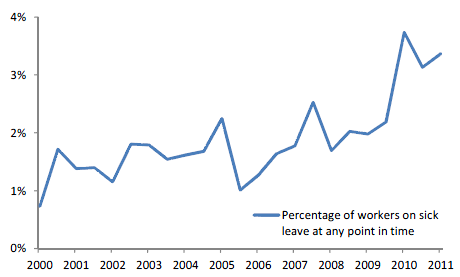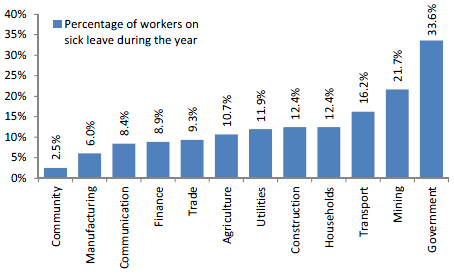Analysis: The sick society
Absence due sickness has increased sharply in South Africa over the past decade. In 2011, at a given point in time 3.4% of workers were on sick leave, whereas a decade earlier, in 2001, 0.7% of workers were absent from work due to sickness. In 2011, 3.4 million workers were absent due to sickness during the year, up from 0.7 million in 2000, an increase of 397%, despite the fact that the number of people employed was essentially flat over the decade. Between 2009 and 2011, one-quarter of all workers took up in full the maximum statutory allowance for sick leave, viz. 36 days in a 3-year cycle. As indicated in the figure, sickness-related absenteeism has increased four-fold since 2007.
Percent of workers on sick leave at any point in time
Source: Statistics South Africa Labour Force Survey (2000-2007) and Quarterly Labour Force Survey (2008-2011)
The cost to the economy has been enormous. Average output per worker in 2011 was R140,855 per year - or R574.92 per working day - with the result that the loss of output due to sickness in 2011 alone totalled R3.9 billion. Cumulatively since 2000, the economy has lost R47.5 billion in real terms due to sickness. Due to the unplanned and unpredictable nature of sick leave, the knock-on disruptive effects on supply chains has probably been greater than these figures suggest, and may have led, in part, to the growing phenomenon of temporary or "contingency" workers, many of whom fill in for employees who are absent from work. As several studies have shown, roughly half (43.7%) of agency workers ("labour broker" workers) are employed as substitutes for absent employees.
Workers on sick leave during the year by industry (percentage of workforce)
Source: Statistics South Africa Quarterly Labour Force Survey (December 2011)
As indicated in the figure, the problem of absenteeism is most pronounced in the government sector, where 33.6% of workers are absent for health reasons during a year, compared to 9.2% for the private sector. Poor managerial oversight, lax administrative controls, outmoded information systems and weak human resource functions in the government sector appear to contribute to the poor control of absenteeism. In addition to government, the heavily unionized mining, transport and logistics and utilities sectors appear to be heavily represented in the sectoral profile of absenteeism in South Africa. Non-unionized sectors - finance, personal services, communication, wholesale and retail trade and agriculture - have the lowest sick leave rates.
Absenteeism arises for many reasons. In genuine cases of illness, the workplace and the nature of the work itself may be implicated in absenteeism. In false cases, the take-up of statutory maximum sick leave allowances is a function of how generous those allowances are, and the degree to which absenteeism is monitored and controlled. It is alarming that sick leave in South Africa has been rising continuously over the past decade, with no signs of reversing.
This is an extract from the Adcorp Employment Index, April 2012, May 10 2012
Click here to sign up to receive our free daily headline email newsletter



